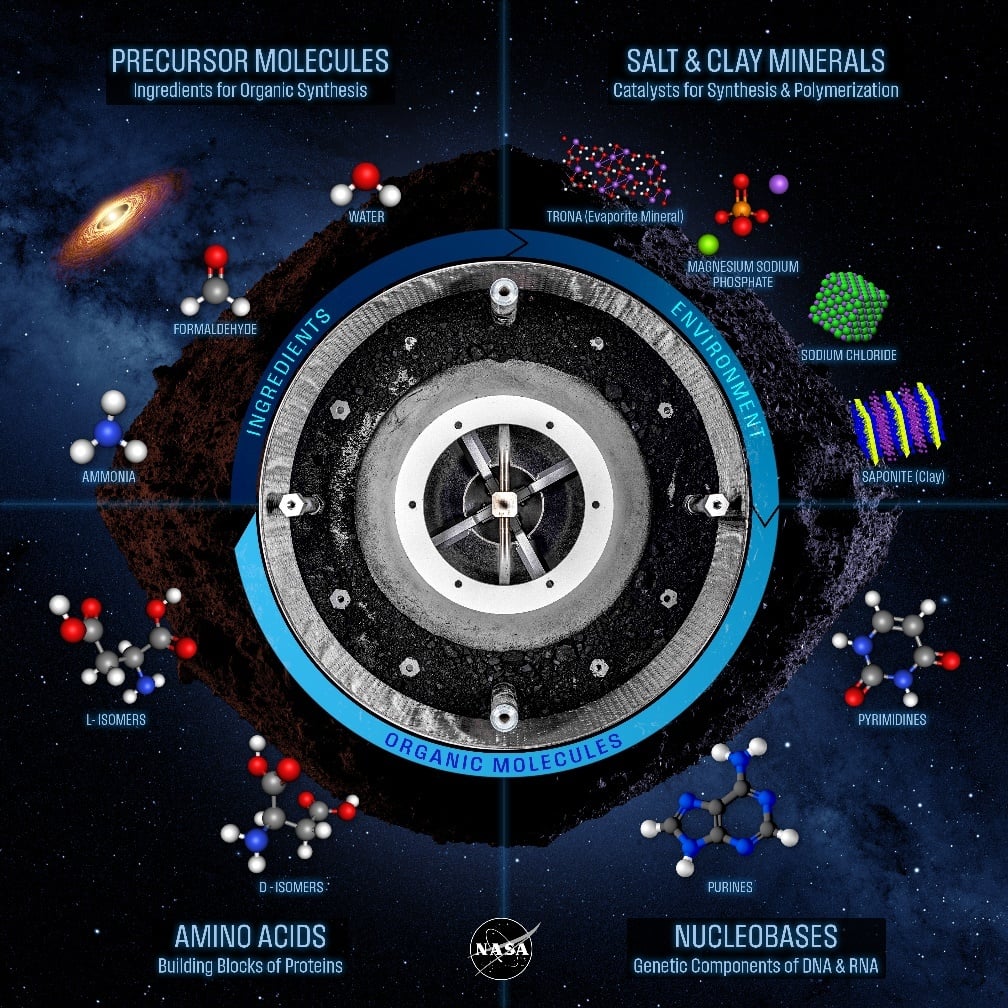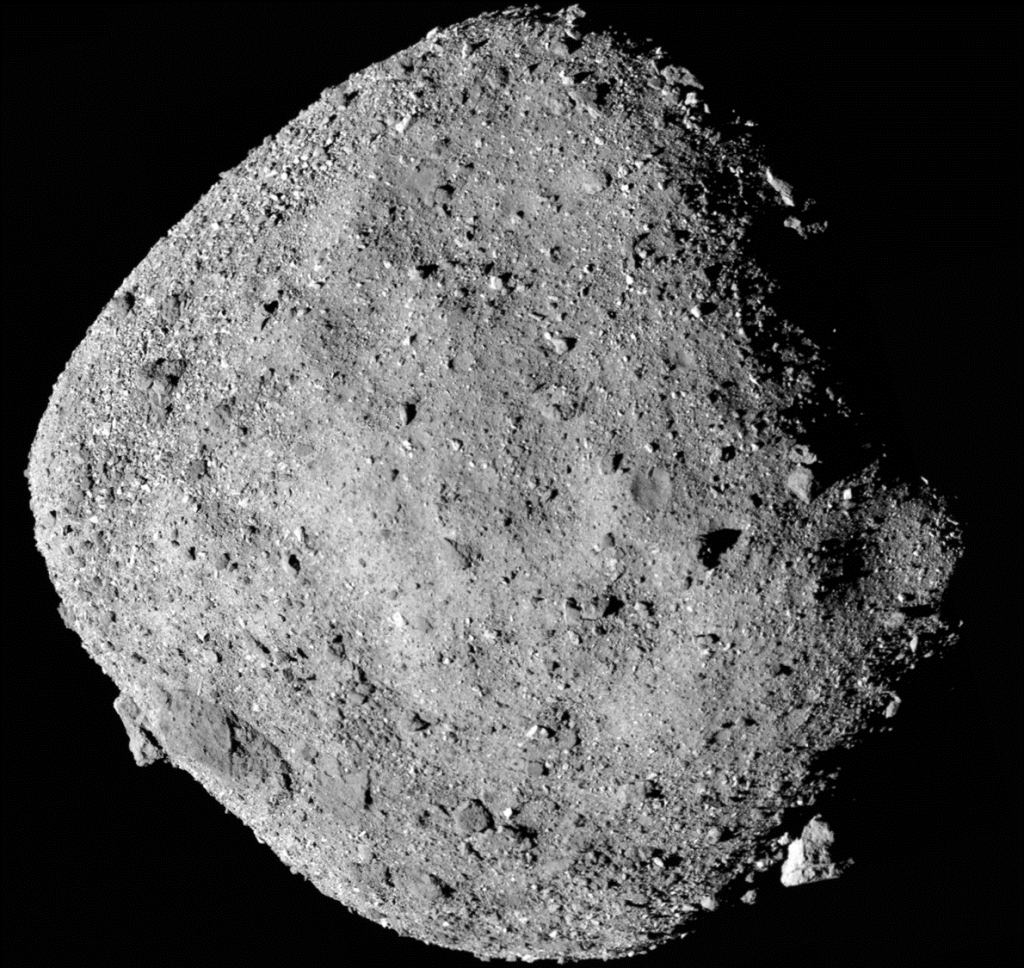The study of asteroid samples is a highly lucrative area of research and one of the best ways to determine how the Solar System came to be. Given that asteroids are leftover material from the formation of the Solar System, they are likely to contain vital clues about how several key processes took place. This includes how water, organic molecules, and the building blocks of life were distributed throughout the Solar System billions of years ago. For this reason, space agencies have attached a high importance to the retrieval of asteroid samples that are returned to Earth for analysis.
This includes NASA's Origins, Spectral Interpretation, Resource Identification, and Security–Regolith Explorer* (OSIRIS-REx*) mission. This spacecraft rendezvoused with asteroid (101955) Bennu on December 3rd, 2018, returning 121.6 grams of material (the largest sample ever) to Earth by September 2023. A recent analysis by scientists from NASA's Goddard Space Flight Center revealed molecules key to life on Earth, including all five nitrogen bases - molecules required for building DNA and RNA. These findings support the theory that asteroids could have delivered the building blocks of life to Earth in the distant past.
The research was led by Daniel P. Glavin and Jason P. Dworkin, two senior scientists with the Solar System Exploration Division (SSED) at NASA Goddard. They were joined by multiple colleagues from the SSED, the Goddard Center for Research and Exploration in Space Science and Technology (CRESST), the Astromaterials Research and Exploration Science Division (ARES) at the NASA Johnson Space Center, and multiple universities and institutes. Their findings were presented in papers that appeared in Nature and Nature Astronomy.
Their results represent the first in-depth analyses of the minerals and molecules in the Bennu samples. Among the most compelling detections (reported in the *Nature Astronomy* paper) were 14 of the 20 amino acids life on Earth uses to make up protein cells. They also detected five nucleobases vital to DNA and RNA, which most complex lifeforms on Earth use to store and transmit genetic instructions, including how to arrange amino acids into proteins. As Associate Administrator Nicky Fox of the Science Mission Directorate at NASA Headquarters explained in a NASA press release:
"NASA's OSIRIS-REx mission already is rewriting the textbook on what we understand about the beginnings of our solar system. Asteroids provide a time capsule into our home planet's history, and Bennu's samples are pivotal in our understanding of what ingredients in our solar system existed before life started on Earth."
The teams also reported exceptionally high abundances of ammonia in the Bennu samples and formaldehyde. Ammonia is an important component in biology since it can react with formaldehyde to form complex molecules like amino acids. These building blocks have previously been detected in other rocky bodies, including meteorites retrieved on Earth. However, the way OSIRIS-REx found them in pristine condition on an asteroid supports the theory that objects that formed far from the Sun could have delivered the raw material for life throughout the Solar System. Said Glavin:
"The clues we're looking for are so minuscule and so easily destroyed or altered from exposure to Earth's environment. That's why some of these new discoveries would not be possible without a sample-return mission, meticulous contamination-control measures, and careful curation and storage of this precious material from Bennu."
Glavin and Dworkin's team analyzed the Bennu samples for hints of compounds related to life on Earth. Meanwhile, Tim McCoy and Sara Russell, the curator of meteorites at the Smithsonian's National Museum of Natural History in Washington and a cosmic mineralogist at the Natural History Museum in London (respectively), looked for evidence of where these molecules formed. As they reported in the study appearing in Nature, they discovered hints that they came from an ancient prebiotic environment.
These included traces of 11 minerals ranging from calcite to halite and sylvite, compounds that form from salts dissolved in water that become solid crystals (brines) once the water dissolves. Evidence of similar brines have been detected on Ceres, Saturn's moon Enceladus, and other bodies in the Solar System. While scientists have also detected brines in meteorites that fell to Earth, they have never seen a complete set created by an evaporation process that could have lasted thousands of years or more. Moreover, some minerals found in Bennu have never been detected in other extraterrestrial samples.
Another analysis was carried out by members of the OSIRIS-REx sample analysis team, including researchers from the Japan Agency for Marine-Earth Science and Technology (JAMSTEC), Hokkaido University, Keio University, Kyushu University, and Tohoku University. Together, they analyzed a 17.75 mg sample using high-resolution mass spectrometry for organic molecules with a ring structure containing carbon and nitrogen (N-heterocycles). This revealed a concentration of N-heterocycles 5-10 times higher than that reported from the sample taken from Ryugu (~5 nmol/g) by the Hayabusa2 mission.
In addition to the five nitrogenous bases, their analysis showed evidence of the purines xanthine, hypoxanthine, and nicotinic acid (vitamin B3). "In previous research, uracil and nicotinic acid were detected in the samples from asteroid Ryugu, but the other four nucleobases were absent," said team member Dr. Toshiki Koga of JAMSTEC. "The difference in abundance and complexity of N-heterocycles between Bennu and Ryugu could reflect the differences in the environment to which these asteroids have been exposed in space."
While these findings have provided compelling evidence of where the building blocks of life on Earth came from, several unanswered questions remain. For starters, amino acids can be created in "mirror-image" versions, similar to how complex lifeforms have a left and right side - hands, feet, brains, lungs, heat chambers, etc. While life on Earth almost exclusively exhibits the left variety, the Bennu samples contain an equal mixture of both. This could mean amino acids started in equal mixtures on Earth billions of years ago but made a left turn along the way.
This is not unlike theories regarding matter and antimatter in the early Universe and how "normal" matter came to be predominant. In any case, these findings are a key piece in the ongoing study of how and where life may have emerged in the Solar System. "OSIRIS-REx has been a highly successful mission," said Dworkin. "Data from OSIRIS-REx adds major brushstrokes to a picture of a solar system teeming with the potential for life. Why we, so far, only see life on Earth and not elsewhere, that's the truly tantalizing question."
Further Reading: NASA, Hokkaido University, *Nature Astronomy*
 Universe Today
Universe Today



